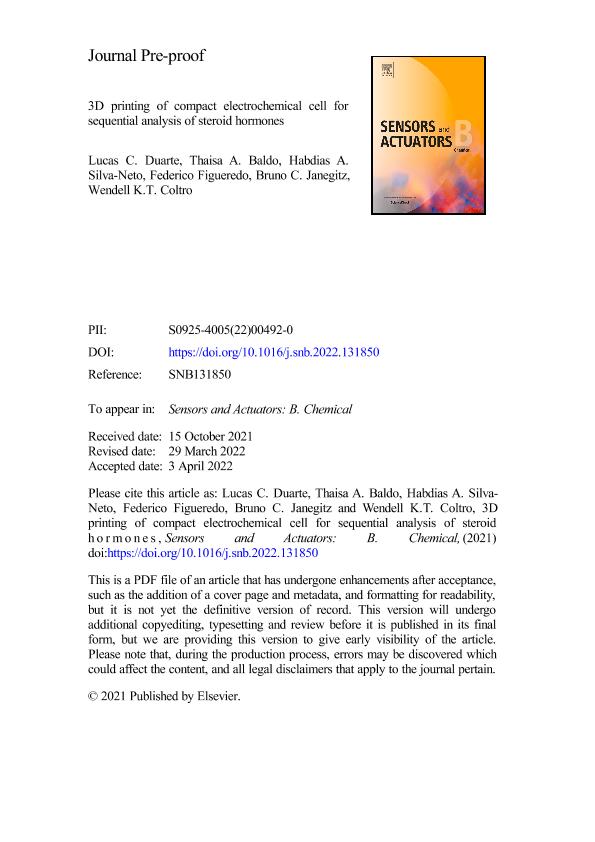Mostrar el registro sencillo del ítem
dc.contributor.author
Duarte, Lucas C.
dc.contributor.author
Baldo, Thaisa A.
dc.contributor.author
Silva Neto, Habdias A.
dc.contributor.author
Figueredo, Federico

dc.contributor.author
Janegitz, Bruno C.
dc.contributor.author
Coltro, Wendell K.T.
dc.date.available
2023-08-28T17:58:00Z
dc.date.issued
2022-08
dc.identifier.citation
Duarte, Lucas C.; Baldo, Thaisa A.; Silva Neto, Habdias A.; Figueredo, Federico; Janegitz, Bruno C.; et al.; 3D printing of compact electrochemical cell for sequential analysis of steroid hormones; Elsevier Science SA; Sensors and Actuators B: Chemical; 364; 8-2022; 1-33
dc.identifier.issn
0925-4005
dc.identifier.uri
http://hdl.handle.net/11336/209620
dc.description.abstract
3D printing technology revolutionized the development of electrochemical sensors allowing the fabrication of custom devices that can be adapted to meet specific applications. This study describes the development of a miniaturized electrochemical cell containing integrated electrodes manufactured entirely by 3D printing for the sequential detection of steroid hormones. The electrochemical sensor was manufactured in a single step by combining two types of thermoplastic filaments. Polylactic acid-Carbon Black (PLA-CB) was used in the electrode region and acrylonitrile butadiene styrene (ABS) was used in the insulating region. Chemical/electrochemical treatments were used to remove the inert polymer matrix and expose the electroactive sites of the CB electrodes. These pre-treatment procedures significantly enhanced the electrochemical response of the printed sensor. The analytical performance of the activated 3D printed electrochemical cell was demonstrated in the sequential detection of estradiol (E2) and progesterone (P4) in artificial urine. The electrochemical cell offered good repeatability (RSD = 3.1%) and reproducibility (RSD = 10.7%) between analyses reaching detection limits of 0.11 and 17.8 µmol L-1 for E2 and P4, respectively. In this sense, these results demonstrate that the use of 3D printing paves the way for the fast and economical fabrication of miniaturized electrochemical cells for hormone detection in biological fluids.
dc.format
application/pdf
dc.language.iso
eng
dc.publisher
Elsevier Science SA

dc.rights
info:eu-repo/semantics/openAccess
dc.rights.uri
https://creativecommons.org/licenses/by-nc-sa/2.5/ar/
dc.subject
3D PRINTED ELECTRODES
dc.subject
ESTRADIOL
dc.subject
FUSED DEPOSITION MODELING
dc.subject
MULTIMATERIAL 3D PRINTING
dc.subject
PROGESTERONE
dc.subject
RAPID PROTOTYPING
dc.subject.classification
Química Analítica

dc.subject.classification
Ciencias Químicas

dc.subject.classification
CIENCIAS NATURALES Y EXACTAS

dc.title
3D printing of compact electrochemical cell for sequential analysis of steroid hormones
dc.type
info:eu-repo/semantics/article
dc.type
info:ar-repo/semantics/artículo
dc.type
info:eu-repo/semantics/publishedVersion
dc.date.updated
2023-07-07T22:48:46Z
dc.journal.volume
364
dc.journal.pagination
1-33
dc.journal.pais
Países Bajos

dc.journal.ciudad
Amsterdam
dc.description.fil
Fil: Duarte, Lucas C.. Universidade Federal de Goiás; Brasil
dc.description.fil
Fil: Baldo, Thaisa A.. Universidade Federal de Goiás; Brasil
dc.description.fil
Fil: Silva Neto, Habdias A.. Universidade Federal de Goiás; Brasil
dc.description.fil
Fil: Figueredo, Federico. Consejo Nacional de Investigaciones Científicas y Técnicas. Oficina de Coordinación Administrativa Ciudad Universitaria. Instituto de Química Biológica de la Facultad de Ciencias Exactas y Naturales. Universidad de Buenos Aires. Facultad de Ciencias Exactas y Naturales. Instituto de Química Biológica de la Facultad de Ciencias Exactas y Naturales; Argentina
dc.description.fil
Fil: Janegitz, Bruno C.. Universidade Federal do São Carlos; Brasil
dc.description.fil
Fil: Coltro, Wendell K.T.. Universidade Federal de Goiás; Brasil. Instituto Nacional de Ciência e Tecnologia de Bioanalítica; Brasil
dc.journal.title
Sensors and Actuators B: Chemical

dc.relation.alternativeid
info:eu-repo/semantics/altIdentifier/url/https://www.sciencedirect.com/science/article/pii/S0925400522004920
dc.relation.alternativeid
info:eu-repo/semantics/altIdentifier/doi/https://doi.org/10.1016/j.snb.2022.131850
Archivos asociados
